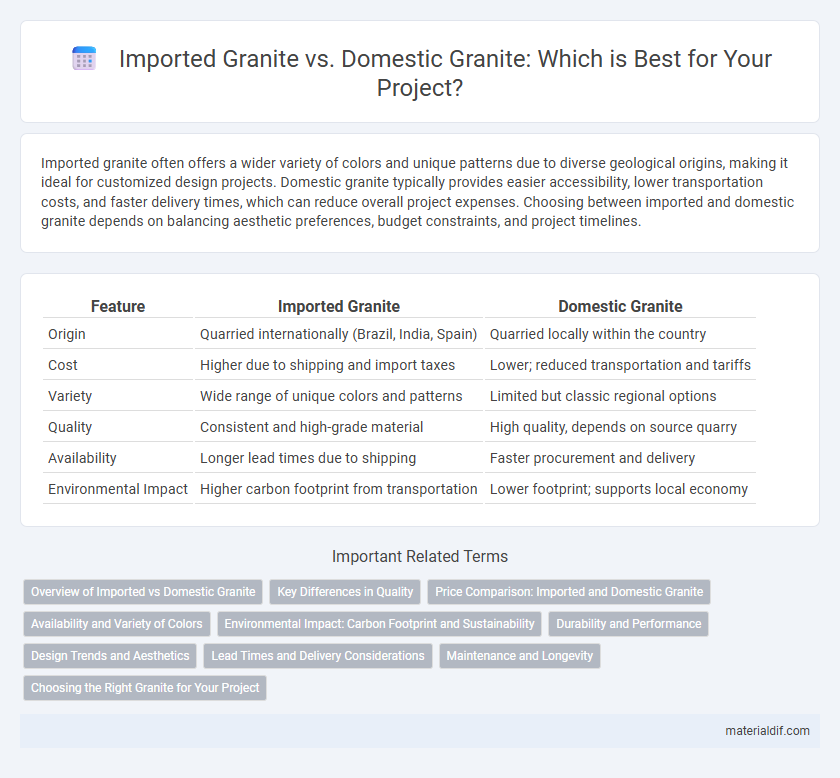Imported granite often offers a wider variety of colors and unique patterns due to diverse geological origins, making it ideal for customized design projects. Domestic granite typically provides easier accessibility, lower transportation costs, and faster delivery times, which can reduce overall project expenses. Choosing between imported and domestic granite depends on balancing aesthetic preferences, budget constraints, and project timelines.
Table of Comparison
| Feature | Imported Granite | Domestic Granite |
|---|---|---|
| Origin | Quarried internationally (Brazil, India, Spain) | Quarried locally within the country |
| Cost | Higher due to shipping and import taxes | Lower; reduced transportation and tariffs |
| Variety | Wide range of unique colors and patterns | Limited but classic regional options |
| Quality | Consistent and high-grade material | High quality, depends on source quarry |
| Availability | Longer lead times due to shipping | Faster procurement and delivery |
| Environmental Impact | Higher carbon footprint from transportation | Lower footprint; supports local economy |
Overview of Imported vs Domestic Granite
Imported granite often features unique colors and patterns sourced from countries like Brazil, Italy, and India, offering high variety and exotic appeal. Domestic granite typically provides more consistent availability, lower transportation costs, and quicker lead times, sourced mainly from U.S. states such as Vermont, Georgia, and South Dakota. The choice between imported and domestic granite depends on factors like price, design preferences, and project timelines, with each option providing distinct advantages based on origin and supply chain dynamics.
Key Differences in Quality
Imported granite typically features unique mineral compositions and color variations due to diverse geological origins, often resulting in higher hardness and distinctive aesthetics. Domestic granite, sourced locally, offers consistent quality with easier supply chain management and competitive pricing, though it may present less exotic patterns. The key quality differences hinge on mineral density, porosity, and finish durability, with imported granite often prized for enhanced scratch and stain resistance.
Price Comparison: Imported and Domestic Granite
Imported granite often carries a higher price tag due to shipping costs, tariffs, and import fees, making it more expensive than domestic granite varieties. Domestic granite benefits from lower transportation expenses and reduced handling charges, leading to more competitive pricing for consumers. Price differences can also vary based on the rarity, color, and quality of the granite sourced from either international or local quarries.
Availability and Variety of Colors
Imported granite offers a wider variety of unique colors and patterns due to sources from diverse geological regions worldwide. Domestic granite typically provides more consistent availability and faster delivery times because of reduced transportation logistics. Choosing between imported and domestic granite depends on the need for exotic aesthetics versus immediate accessibility and supply reliability.
Environmental Impact: Carbon Footprint and Sustainability
Imported granite generally has a higher carbon footprint due to long-distance transportation and overseas shipping emissions, significantly impacting its overall environmental cost. Domestic granite reduces transportation-related carbon emissions and supports local quarrying practices, often contributing to more sustainable land management and reclamation efforts. Choosing domestic granite can promote lower environmental impact and better alignment with sustainability goals in construction projects.
Durability and Performance
Imported granite typically offers a diverse range of colors and unique patterns, often sourced from countries like Brazil, Italy, and India, known for high-quality stone. Domestic granite, quarried within the United States, usually provides better performance in terms of durability due to shorter transportation times, reducing the risk of damage and preserving stone integrity. Both types demonstrate excellent resistance to heat, scratches, and stains, but domestic granite often features denser composition, enhancing its long-term durability in high-traffic areas.
Design Trends and Aesthetics
Imported granite offers a broader palette of unique colors and intricate veining patterns, aligning with modern design trends that favor bold, statement surfaces in luxury kitchens and bathrooms. Domestic granite typically features more subdued tones and consistent patterns, appealing to minimalist and rustic aesthetics that prioritize natural, earthy textures. Designers increasingly mix imported granite's dramatic visual appeal with domestic stone's durability to create balanced, sophisticated interiors.
Lead Times and Delivery Considerations
Imported granite often involves longer lead times due to international shipping, customs clearance, and potential delays at ports, which can extend delivery schedules by several weeks compared to domestic granite. Domestic granite benefits from shorter transportation distances, faster processing times, and more reliable delivery windows, reducing overall project timelines significantly. Choosing domestic granite enhances scheduling predictability and minimizes risks related to shipment delays and extended inventory hold times.
Maintenance and Longevity
Imported granite often features dense mineral compositions that enhance its durability and resistance to scratches and stains, resulting in lower maintenance requirements over time. Domestic granite varies widely in hardness and porosity, influencing the frequency of sealing and cleaning necessary to preserve its appearance and structural integrity. Choosing granite based on specific mineral content and finish can optimize longevity and reduce upkeep costs.
Choosing the Right Granite for Your Project
Imported granite offers unique color variations and exotic patterns that can elevate custom design projects, while domestic granite provides easier availability and typically lower shipping costs. Understanding the specific application and budget constraints helps determine whether the rich aesthetics of imported granite or the cost-effectiveness of domestic granite better suits your project's needs. Consider factors such as durability, maintenance, and project timeline to ensure the granite choice enhances both functionality and style.
Imported Granite vs Domestic Granite Infographic

 materialdif.com
materialdif.com